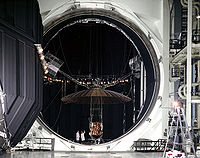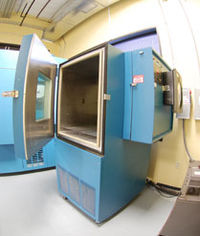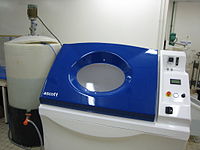- Environmental chamber
-
An environmental chamber is an enclosure used to test the effects of specified environmental conditions on biological items, industrial products, materials, and electronic devices and components. Environmental chambers help evaluate product quality and reliability, and identify manufacturing flaws and weaknesses.[1] By simulating environmental conditions within a contained space, the chamber offers test results that can show the process of product decay and degradation and help predict the potential lifespan of a product or material.
Such a chamber can be used:
- as a stand-alone test for environmental effects on test specimens
- as preparation of test specimens for further physical tests or chemical tests
- as environmental conditions for conducting testing of specimens
Contents
Overview
 Large NASA vacuum chamber.
Large NASA vacuum chamber.
An environmental test chamber artificially replicates the conditions under which machinery, materials, devices or components might be exposed. It is also used to accelerate the effects of exposure to the environment, sometimes at conditions not actually expected.
These conditions may include:
- extreme temperatures
- sudden and extreme temperature variations
- moisture or relative humidity
- electrodynamic vibrations
- electromagnetic radiation
- salt spray
- rain
- weathering
- exposure to sun, causing UV degradation
- vacuum
Manufactured samples, specimens, or components are placed inside the chamber and subjected to one or more of these environmental parameters to determine reliability or measure after-effects such as corrosion. In the case of machinery such as internal combustion engines, byproducts such as emissions are monitored.
An environmental chamber can be a small room used both to condition test specimens and to conduct the test. It can be a smaller unit that's used for conditioning test items. Also, some chambers are small enough to be placed onto a universal testing machine or other test apparatus.
Many chambers are set at a certain set of conditions. Others can be programed to cycle through specified sequences of conditions.
Design
As test requirements may be relatively simple or complex, environmental test chambers vary widely in size, ranging from small units designed for placement on bench tops to large walk-in chambers. Test chambers generally have viewports or video feeds to allow for visual inspection of the sample during the test. Reach-in chambers provide an opening that technicians may use to handle test samples. Chambers providing interior visual lighting must take into account the heat generated and compensate accordingly.
As with the wide variance in size, a number of user control options are available, ranging from simple analog indicators up to more modern digital readouts with LCD displays. Chambers may be computer programmable, and networked or Web-enabled test chambers are also available.[2]
Test chamber standards
The Institute of Environmental Sciences and Technology is a leading source of standards for environmental test chambers.[3] In addition, the following organizations provide guidance on environmental test chamber construction, temperature control standards, and engineering tolerances.
- Air Conditioning, Heating and Refrigeration Institute (formerly the American Refrigerant Institute)
- American Society of Heating, Refrigerating, and Air-Conditioning Engineers Air conditioning#American Society of Heating, Refrigerating, and Air-Conditioning Engineers
- ASTM International
- Underwriters Laboratories
- NSF International
- Factory Mutual
- Canadian Standards Association
- International Organization for Standardization
See also
- Doriot Climatic Chambers
- Accelerated aging
- Environmental stress screening
- MIL-STD-810, DoD Standard for Environmental Engineering Considerations and Laboratory Tests
- Shelf life
- Standard conditions for temperature and pressure
- Thermo-mechanical fatigue test
- Universal testing machine
- Weather testing of polymers
External links
- A climate chamber for simulating temperature and humidity
- About HALT and HASS environmental chambers
References
Categories:
Wikimedia Foundation. 2010.


